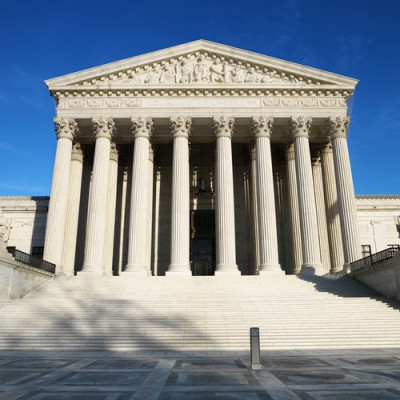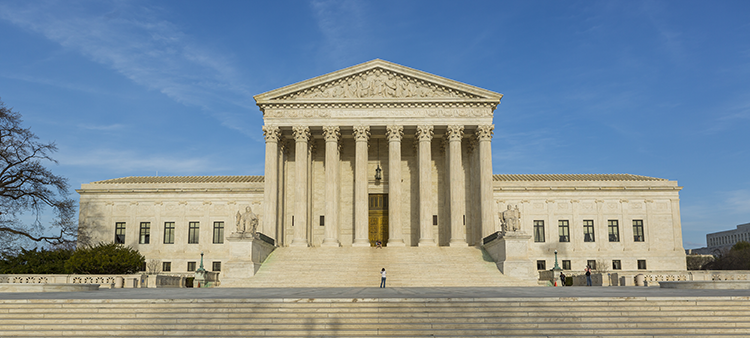In 2 summary reversals, Supreme Court rules for officers who kneed and shot suspects

Image from Shutterstock.
In two summary reversals Monday, the U.S. Supreme Court ruled for police officers who kneed a suspect with a knife and fatally shot another man wielding a hammer.
The Supreme Court ruled in both cases that police were entitled to qualified immunity because no precedent put them on notice that their actions were illegal. The precedent cited by two appeals courts in the cases was not squarely on point, the high court said.
In the first case, Rivas-Villegas v. Cortesluna, the Supreme Court reversed the 9th U.S. Circuit Court of Appeals at San Francisco, which had ruled for Ramon Cortesluna in his suit against an officer who kneed him.
Police in Union City, California, had been called to the scene as a result of a 911 call from a 12-year-old girl who said she was shut inside a room with her mother and sister. The girl reported that the mother’s boyfriend had a chainsaw and was trying to hurt them. The girl said the boyfriend was using the chainsaw to break something in the house. The 911 operator heard sawing in the background.
Officers knocked on the door and told Cortesluna to “drop it” when an officer reported that he had a weapon. Cortesluna dropped what turned out to be a metal tool. Officers told Cortesluna to come out with his hands up and then told him to get on his knees. An officer saw a knife sticking from Cortesluna’s pocket and told him to keep his hands up, but Cortesluna lowered his hands. He finally complied after being shot twice with a beanbag gun.
Cortesluna followed directions to get down. An officer placed his knee on the left side of Cortesluna’s back, near the knife, and raised Cortesluna’s hands behind his back. The officer was on Cortesluna’s back for no more than eight seconds.
The 9th Circuit had found that the officer did not have qualified immunity from the suit based on a prior 9th Circuit case involving a suspect accused by neighbors of making too much noise. In that case, an officer deliberately dug a knee into the back of an unarmed suspect who was no longer resisting arrest. The officer used such force that the kneeing caused a long-term and possibly permanent back injury.
The Supreme Court said the cases were different, and the officer who kneed Cortesluna was entitled to qualified immunity.
In the second case, City of Tahlequah, Oklahoma v. Bond, the Supreme Court reversed the 10th Circuit at Denver, which had ruled for the estate of Dominic Rollice, who was fatally shot by police.
Officers had been called to the home of Rollice’s ex-wife, who said Rollice was intoxicated and would not leave her garage. Although Rollice did not live at the home, he kept his tools in the garage.
Officers noticed something in Rollice’s hand and asked whether they could pat him down for weapons. He refused. An officer took one step toward Rollice.
Rollice walked to the back of the garage. Officers followed him, but none was within 6 feet of Rollice. Rollice grabbed a hammer.
Rollice turned toward police and held the hammer as if preparing to swing a baseball bat. Officers drew their guns and shouted at Rollice to drop the hammer. Instead, he raised the hammer to the back of his head and took a stance as if he was about to throw the hammer or charge the officers.
The officers fired their weapons, killing Rollice.
The 10th Circuit said its precedent held officers liable for shootings if their reckless or deliberate conduct created a situation requiring deadly force. The 10th Circuit said the officers’ “cornering” of Rollice could be seen as recklessly creating the situation.
The 10th Circuit said the officers were not entitled to qualified immunity because of past cases holding that such conduct was unlawful.
The Supreme Court said none of the cases cited by the 10th Circuit “comes close to establishing that the officers’ conduct was unlawful.”
“We have repeatedly told courts not to define clearly established law at too high a level of generality,” the Supreme Court said.
“It is not enough that a rule be suggested by then-existing precedent,” the high court said. Instead, the “rule’s contours must be so well defined that it is ‘clear to a reasonable officer that his conduct was unlawful in the situation he confronted.’”



